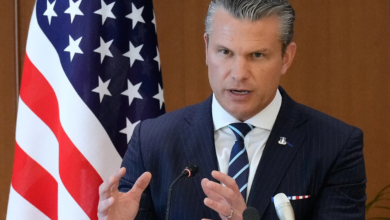What immigration panorama will Biden receive?
Several Central American countries have changed their immigration policies in the face of strong pressure from Trump .

The Department of Homeland Security reported what are the measures that it leaves ready for the new cabinet of the United States. / Photo: TW-DHS_Wolf
Santiago Gómez Hernández
Listen to this article
Leer en español: ¿Qué panorama migratorio recibirá Biden?
This week the outgoing secretary of the United States Department of Homeland Security (DHS), Chad Wolf, reported through his Twitter account that El Salvador will begin to apply the Migration Cooperation Agreement (ACA for its acronym in English).
Grateful to President @nayibbukele & the Government of El Salvador for their commitment to the implementation of the Asylum Cooperative Agreement and ensuring we expand the vital avenues for migrants seeking protection in the region. https://t.co/U3R2RVXtDM pic.twitter.com/O7c9X97eG1
— Acting Secretary Chad Wolf (@DHS_Wolf) December 16, 2020
This is a new victory for the interests of President Donald Trump and the anti-immigrant sector to hinder migration from Central America and facilitate the sending of refugees to this region. According to DHS figures in 2019, 71% of the migrants held at the southern border come from Honduras, Guatemala and El Salvador.
However, entities such as Human Right Watch have warned of the danger that accompanies the implementation of the ACA. In a May 2020 report it warns that in the case of Guatemala: "Given Guatemala's inability to provide effective protection and the risk that some of those transferred may face the threat of serious harm in Guatemala or after returning to their home countries, the United States violates its national and international obligations of non-refoulement by failing to examine the asylum applications of asylum seekers who are forcibly sent to Guatemala. "
El Salvador
This agreement, which was signed in 2019 by several Central American governments, allows the United States to transfer migrants seeking asylum or some humanitarian protection at their southern border to these countries. According to the text, El Salvador will be in charge of providing protection to these asylum seekers.
This agreement received much criticism, since the White House threatened to withdraw economic support and increase trade rates to countries that refused to sign it. This led to the signing by Honduras, Guatemala and El Salvador.
Mexico
After threatening to withdraw from the North American Free Trade Agreement (NAFTA), the United States managed to convince the government of Andrés Manuel López Obrador to launch the "Stay in Mexico" policy. This means that migrants can wait in Mexico while their asylum process is responded to favorably.
However, AMLO refused for Mexico to be declared as a refugee recipient country. This is why Washington had to look to Honduras, Guatemala, and El Salvador for the destination of those refugees seeking asylum in the United States. In this way, a Honduran citizen who requests asylum in the United States and is rejected will be sent to a different country from the one they come from.
There are also criticisms of the "Stay in Mexico" policy. Entities such as WOLA (promoter of human rights in the Americas) warn, for example, that this migration policy has put migrants stranded at the border at risk of violence and health issues.
Also read: What will Biden's relationship with Venezuela and Maduro be like?
Biden Administration
It is still too early to know what policy President-elect Joe Biden will adopt. However, conclusions can be drawn from the Obama administration (in which Biden was vice president) and the recent appointments.
The new administration is unlikely to back down or eliminate these policies achieved by Donald Trump. Let us remember that during the presidency of Barack Obama, the United States deported more than 2.7 million illegal immigrants, the highest number of any other president, something that Biden never reproached.
As the new secretary for DHS will be Alejandro Mayorkas, key in improving relations between the United States and Cuba. Mayorkas, a Cuban-American, will be the first immigrant to occupy this portfolio.
When I was very young, the United States provided my family and me a place of refuge. Now, I have been nominated to be the DHS Secretary and oversee the protection of all Americans and those who flee persecution in search of a better life for themselves and their loved ones.
— Alejandro Mayorkas (@AliMayorkas) November 23, 2020
With this new migration landscape, Biden will be able to focus on his campaign promises to normalize the situation of the 11 million undocumented immigrants currently living in the United States.




